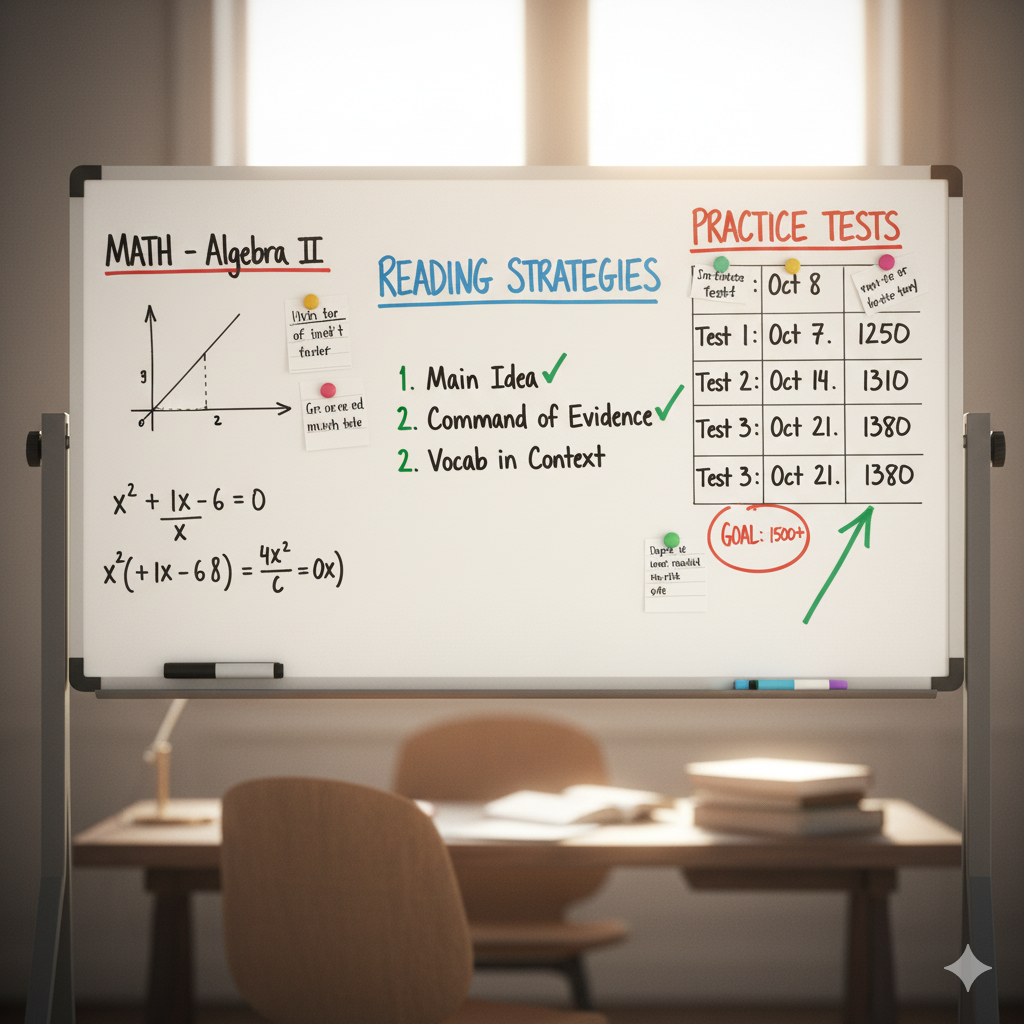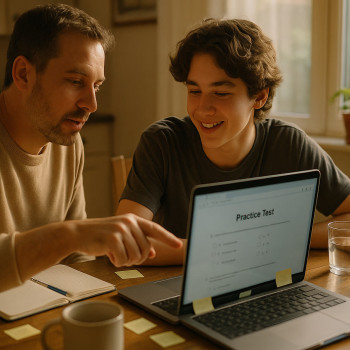The Student Psychology of Seeing SAT Scores Improve
There’s a particular kind of electric thrill that runs through you the first time you see your SAT score tick up. It might be just a handful of points — five, ten, maybe twenty — but the feeling is disproportionate to the number. Why does a small jump in a number on a screen feel like the sun has risen differently? Because test scores are more than numbers: they’re narratives we tell ourselves about ability, progress, and the future.
Why SAT score improvements feel so powerful
When you prepare for a big exam, your mind is invested in the outcome. The SAT sits at an odd intersection: it measures skills you’ve been building for years while also acting as a gatekeeper for college opportunities. That combo makes every improvement psychologically meaningful. Here are the reasons a small score bump can feel huge:
- Tangible evidence of effort: Score gains translate hours of study into something visible and objective. That confirmation reduces the fuzziness of “Did I improve?” into a clear yes.
- Momentum and motivation: Improvements, even modest ones, trigger motivation systems in the brain. You’re more likely to keep studying because you’ve proved the process works.
- Reframing self-belief: An upward nudge shifts identity: you stop thinking “I’m not an SAT person” and start thinking “I can get better.” Identity change is one of the most powerful predictors of sustained improvement.
- Anxiety reduction: Test anxiety often comes from uncertainty. Seeing a higher score reduces that uncertainty and calms physiological responses the next time you approach practice or a real test.
Small wins compound: the psychology of incremental improvement
Improvement rarely looks like a straight line. It’s a series of small wins, plateaus, and occasional setbacks. That’s okay — in fact, it’s normal. A principle from behavioral science called the “progress principle” shows that people who notice forward movement feel more engaged and satisfied. For SAT prep, that means the first small uptick in practice-test scores can catalyze a virtuous cycle:
- You see a small gain.
- Your confidence increases.
- You study a little smarter and with more focus.
- You perform slightly better again.
Repeat this and over time the gains add up. The psychological shift is just as important as the raw score: students become learners who plan, adjust, and bounce back, instead of feeling stuck or defeated.
Common psychological barriers and how improvement addresses them
1. The “fixed ability” mindset
Many students start with the belief that intelligence — and therefore test skill — is a fixed trait. A modest score increase undermines that belief by offering concrete proof that change is possible. This pivot from a fixed to a growth mindset is vital: students who believe they can improve are more likely to persist through challenges.
2. Perfectionism and fear of failure
Perfectionists often delay practice because they’re afraid of seeing low scores. But encountering imperfect results and then improving teaches resilience. Each score improvement reduces the sting of failure and shows that errors are learning opportunities, not proofs of unworthiness.
3. Test anxiety and physiological stress
As your performance improves in practice, your body learns that the situation (a test environment) is less threatening. That learning translates to calmer breathing, steadier focus, and better recall on test day. In psychological terms, exposure + mastery = desensitization.
How to turn small score gains into sustained growth
Improving is one thing; sustaining and accelerating that improvement is another. Below are actionable strategies that bridge the gap between occasional boosts and real, long-term score growth.
1. Use targeted practice, not just more practice
Quantity is tempting: the more problems you do, the faster you’ll improve, right? Not necessarily. The most efficient gains come from targeted practice — deliberately working on the specific content and reasoning patterns that hold you back.
- Identify 2–3 persistent weaknesses from your diagnostic tests (e.g., grid-in algebra problems, inference questions in reading).
- Create micro-sessions (20–40 minutes) focused solely on those areas.
- After each session, do a quick reflection: what changed, what still confuses you?
2. Simulate real testing conditions
One of the most common gaps between practice and test day is environment. If you always practice with pauses, snacks, or help nearby, your brain won’t learn to perform under constraints. Use timed, distraction-free practice that mirrors the digital SAT environment. Over time, the test situation feels normal rather than frightening.
3. Anchor learning in meaning
The brain remembers better when new knowledge connects to what it already knows. Instead of memorizing rules in isolation, link them to real examples, mistakes you’ve made, or memorable analogies. This is why explanations — why an answer is right or wrong — matter more than simply reviewing answers.
4. Make a feedback loop
Track progress not only in scores but in behaviors. Keep a short journal that logs:
- Practice time and focus level
- Types of problems practiced
- Key mistakes and strategies to fix them
- Mood and energy
After two weeks, review the journal to identify patterns. This kind of reflective practice converts vague hope into actionable insight.
Practical schedule: turning your weekly improvements into monthly gains
Below is a realistic 8-week schedule for a student aiming for steady, sustainable improvement. It’s flexible — adjust focus areas based on diagnostic results and practice-test trends.
| Week | Focus | Goal | Weekly Time |
|---|---|---|---|
| 1 | Diagnostic + baseline habits | Identify weaknesses; set schedule | 6–8 hrs |
| 2 | Targeted practice (top 2 weaknesses) | Raise accuracy on weakest topics by 10% | 6–8 hrs |
| 3 | Timed sections + strategy work | Improve timing and pacing | 6–9 hrs |
| 4 | Full practice test + review | Measure progress; update plan | 8–10 hrs |
| 5 | Deep-dive weaknesses + mixed practice | Consolidate gains | 7–9 hrs |
| 6 | Timed tests + stress management | Reduce anxiety; keep gains consistent | 7–9 hrs |
| 7 | Full practice test + fine-tuning | Polish strategies for final test | 8–10 hrs |
| 8 | Light review + rest | Maintain sharpness without burnout | 4–6 hrs |
How to measure whether improvement is “real”
Not all score increases are equally meaningful. A realistic approach looks for trends across multiple, consistent measures:
- Improvement across two or more full-length practice tests.
- Fewer careless errors and more correct answers on previously weak topics.
- Faster, more confident pacing — not just speed for the sake of speed.
- Greater comfort in simulated test environments.
When those elements align, your score increases are likely to hold on actual test day.
The social and emotional side: who you become as you improve
Improvements change how you talk to yourself and others. That’s not trivial — it affects study habits, relationships, and even college decisions. Here are common social and emotional shifts students report:
- More willingness to ask for help: as you prove improvement is possible, you’re less ashamed to reveal gaps and seek guidance.
- Better planning and time management: momentum breeds structure. Small wins often encourage students to set weekly study goals and stick to them.
- Reduced fear of application season: rising scores make essays, recommendations, and interviews feel less like make-or-break moments.
These shifts feed each other — social support and emotional steadiness accelerate learning just as much as practice does.
Real-world example: from 1240 to 1360 (hypothetical but typical)
A student begins with a diagnostic composite of 1240. Their main issues are timing in the Math section and inaccurate readings of inference questions in Reading & Writing. Over eight weeks, they:
- Spend five targeted sessions on grid-in strategies and common algebraic structures.
- Practice inference questions with paraphrasing and evidence-mapping.
- Implement timed-section drills twice a week and one full-length simulated test every two weeks.
By week four, the student sees a 40-point gain mainly from fewer careless errors. By week eight, a practice test shows a composite of 1360. The jump is the result of targeted practice and improved pacing — and psychologically, the student now approaches test day with curiosity instead of dread.
How personalized support accelerates the psychological shift
Guidance tailored to you — not generic advice — reshapes not only skills but confidence. Personalized tutoring can identify subtle patterns: a recurring misconception in algebra, a mental block on data interpretation, or a timing habit that wastes minutes. When feedback is precise, improvements come faster, and the psychological benefits arrive sooner.
For many students, services like 1-on-1 tutoring provide a safe space to fail and iterate. A tutor’s role is part teacher, part coach: they diagnose, design a plan, and help manage emotions around setbacks. Tools that add AI-driven insights can highlight trends in practice data, suggest micro-skills to target, and create adaptive practice schedules that fit your life. If personalized help fits your budget and learning style, it often shortens the path from small gains to big, reliable improvements.
Note: Sparkl’s personalized tutoring model, which combines one-on-one guidance, tailored study plans, expert tutors, and AI-driven insights, is a good example of how individualized attention can accelerate both skill growth and the confidence that comes with it — particularly for students who feel stuck or overwhelmed.
Practical tips to protect your gains on test day
- Practice under test-like conditions multiple times in the final month. Familiarity reduces surprises.
- Keep a “pre-test ritual” of sleep, nutrition, and a short warm-up. Routine calms nerves.
- On test day, focus on process over outcome: trust your pacing, note flags for hard problems, and return if time allows.
- Use post-test reflection, whatever the result: celebrate the preparation and analyze what to change next.
Final thoughts: beyond the score
Improving an SAT score is not just an academic milestone — it’s a microcosm of how you learn, adapt, and build self-trust. The most important lesson isn’t the number itself but the proof that effort and strategy can change outcomes. That evidence shapes future challenges: choosing tougher classes, applying to ambitious colleges, or tackling difficult projects with less fear.
If you’re in the middle of prep: welcome the small wins. Track them, celebrate them, and let them rewrite your story about what you’re capable of. If you’re coaching or supporting someone else, remember that encouragement, clear feedback, and smart structure often matter more than one more hour of unguided study.
Above all, be kind to yourself. Improvement is rarely tidy, but it is reliable when you combine deliberate practice, honest reflection, and a willingness to adjust. The next time you see your score climb, take a beat to register what it means: proof that you can grow — and a reminder that the next goal is within reach.
Action steps right now
- Take a timed diagnostic to establish a baseline.
- Pick one weak area and design three 30-minute targeted sessions this week.
- Schedule a full-length, timed practice test in two weeks and plan a calm post-test review.
- Consider a short consultation with a personalized tutor to see if 1-on-1 guidance or AI-driven insights could accelerate your plan.
Small steps. Measured practice. A little celebration along the way. That’s how numbers change — and how confidence grows.
















No Comments
Leave a comment Cancel